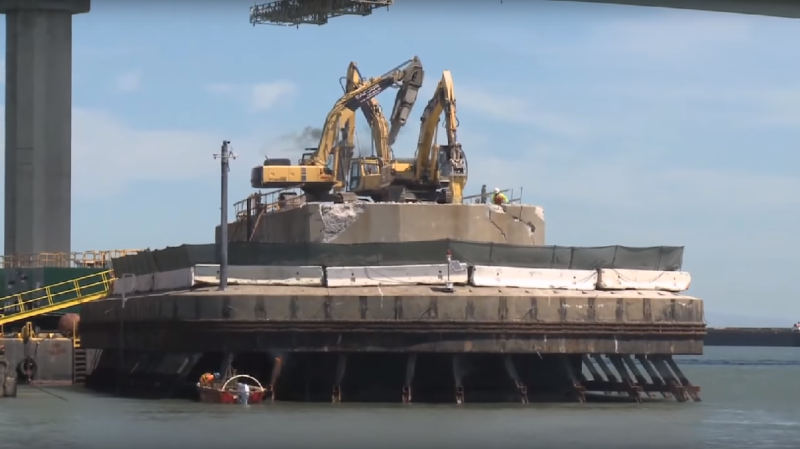Caltrans announced the change in plans Tuesday, saying that it had rejected the explosives that were to be used in the demolition.
The issue, Caltrans chief bridge engineer Brian Maroney told reporters, was how the explosive are packaged.
“We have to push it down holes, and we want that outside material to be tough," Maroney said. "I don’t want to fiddle around with potentially the outside material ripping as we push it down a hole.”
While it sounds spectacular -- you might be imagining a section of the old span dropping into the water "Bridge on the River Kwai" style -- the reality is supposed to be pretty low key. Most of the structure to be removed is below the bay's surface, so there will be no spectacular collapse. No, there won't be a geyser shooting skyward either.
"If you want to see it, stay home and watch it on the Internet," Maroney said.
The structure to be removed is Pier E3, the largest of the old span's foundations. The structure, near Yerba Buena Island, extends 50 feet from the water's surface to the bay floor and then for more than 200 feet into the bay mud below.
The implosion is designed to destroy the pier above the bay floor as well as most of the structure embedded in the mud. Caltrans says it's worked with several outside agencies to make sure the implosion's impact on surrounding wildlife and infrastructure is limited.
Engineers have devised a large platform of floating planks -- an attenuation mat -- to limit the spread of debris. An underwater bubble curtain will be in place, a measure designed to reduce the energy of the shock wave from the explosives detonated during the implosion.
Maroney said the blast itself has been designed to minimize its destructive effects.
"By having just under 600 different charges -- not released all at once, set off microseconds apart -- you don’t have one big shock wave, you have many small shock waves," Maroney said. "So the amplitude or the threat of that shock wave is much, much less.”
The implosion is set to take place at the time of a slack tide, the point when a high tide has reached its maximum or a low tide its minimum.
Maroney said the most likely time for the operation is at the midday high tide on Saturday, Nov. 14 -- about 1 p.m. But it could take place at the morning low tide, about 6:45 a.m., or sometime the following day.
He said a major factor in determining the time is minimizing impacts on mammals such as seals, sea lions and porpoises, and monitors will be watching them closely to help pick the safest time.
The implosion will have a brief impact on boaters, bicyclists and motorists on the Bay Bridge, and BART passengers.
The California Highway Patrol will halt bridge traffic briefly at the time of the operation. Westbound traffic will be held at the Bay Bridge metering lights; eastbound traffic will be halted at the western portal to the Yerba Buena tunnel. The bike path on the new eastern span will also be closed beginning at 6 p.m. on Friday, Nov. 13, until the implosion is over.
BART says it will hold trains outside the Transbay Tube, which will result in slight delays. And boats will be barred from traveling within 1,500 feet of the blast site.
Larry Goldzband, executive director of the San Francisco Bay Conservation and Development Commission, said, "The implosion is not perfect and species will be killed," but he said the implosion will cause less environmental damage than other methods of demolishing the pier.
Goldzband said the alternative of mechanically removing the pier would take up to four years and require building a dam around it, which he said would significantly disrupt area wildlife and be difficult to manage and mitigate.
This post contains reporting by KQED's Andrew Stelzer and Bay City News.

